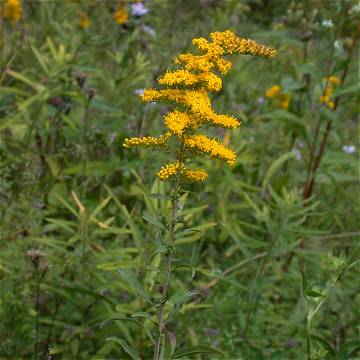

Solidago nemoralis - (image 1 of 5)
Taxonomy
Family: Asteraceae
There are three recognized varieties, two of which occur in the northeastern U.S. Relatively robust plants with ample and open inflorescences and long, divergent branches, and numerous and conspicuously reduced upper leaves are considered var. haleana Fernald. Less robust plants, with rather compact or narrow and elongate inflorescences and upper leaves more gradually reduced are considered var. nemoralis.
The other variety is more common in the Great Plains, and is called var. longipetiolata (Mack. & Bush) E.J. Palmer & Steyerm; it is a tetraploid and more robust than the other, diploid varieties. It may warrant species status, in which case it would be called S. decemflora DC.
Habitat
Old fields, remnants of dry prairies, lake dunes, sandy black oak savanna.
Associates
In old fields with Ambrosia artemisiifolia elatior, Aster pilosus, Fragaria virginiana, Hypericum perforatum, Monarda fistulosa, Potentilla simplex, Rudbeckia hirta.
Distribution
Nova Scotia west to Alberta, south FL to TX.
Morphology
Short herbaceous perennial. Leaves gradually reduced in size from near the base of the plant into the inflorescence. Cauline leaves finely pubescent, somewhat scabrous, the blades of the lower ones more than 4.5 times as long as wide, usually long-tapered into the petiole, subentire or serrate-crenate with low teeth. Flowers yellow; heads in terminal panicles, secund along the upper side of the branches.
Notes
Flowers early August to early November
Wetland indicator: Upland
Sometimes called Gray Goldenrod because of the somewhat downy surface of the leaves.
References
Gleason, Henry A. and A. Cronquist. 1991. Manual of Vascular Plants of
Northeastern United States
and Adjacent Canada. Second Ed.
The New York Botanical Garden. Bronx, NY
Swink, F. and G. Wilhelm. 1994. Plants of the Chicago Region.
Indiana Academy of Science. The Morton Arboretum. Lisle, Illinois.
|
Michael Hough © 2005 |